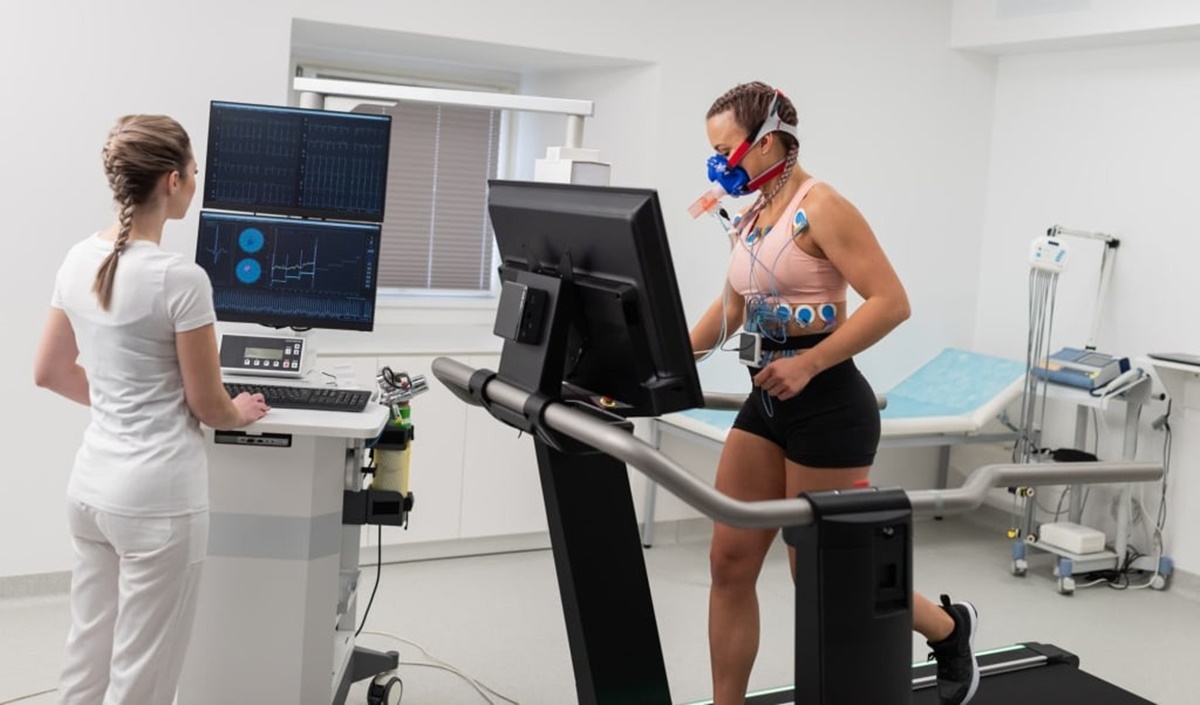Home>Misc>Featured>Which Areas Are Evaluated Using The National Institutes Of Health Stroke Scale (NIHSS)


Featured
Which Areas Are Evaluated Using The National Institutes Of Health Stroke Scale (NIHSS)
Published: September 12, 2023
Discover the areas evaluated in the National Institutes of Health Stroke Scale (NIHSS) using our featured tool. Assessments include motor function, speech, and more.
Introduction
The National Institutes of Health Stroke Scale (NIHSS) is a standardized tool used by healthcare professionals to assess the severity of stroke in patients. The NIHSS evaluates various neurological functions to determine the extent of brain damage and the impact on the patient”s overall functioning. This scale plays a crucial role in guiding treatment decisions and predicting patient outcomes.
Stroke is a medical emergency that occurs when blood flow to the brain is interrupted, leading to damage or death of brain cells. It is essential to assess the severity of stroke accurately and promptly to provide appropriate interventions and optimize patient care. The NIHSS provides a comprehensive evaluation of key areas affected by stroke, including motor function, sensory function, language and speech, as well as level of consciousness.
This article will delve into the different areas that are evaluated using the NIHSS. We will explore each component individually, providing a detailed understanding of the assessment process. By the end of this article, you will have a comprehensive knowledge of the NIHSS and its various components.
It is important to note that the NIHSS should only be administered by trained healthcare professionals who are familiar with its administration and interpretation. This tool should not be used as a standalone diagnostic tool but rather as part of a comprehensive evaluation of stroke patients.
Now, let”s explore the important areas that are evaluated using the National Institutes of Health Stroke Scale.
Overview of the National Institutes of Health Stroke Scale (NIHSS)
The National Institutes of Health Stroke Scale (NIHSS) is a standardized assessment tool specifically designed to evaluate various neurological functions in patients who have experienced a stroke. It was developed by the National Institute of Neurological Disorders and Stroke (NINDS) to provide a systematic and reliable measure of stroke severity.
The NIHSS is widely used in clinical practice and research settings to determine the degree of stroke-related disability and to guide treatment decisions. It assesses different areas of functioning, including level of consciousness, language and speech, motor function, sensory function, and visual fields.
The scale consists of 15 individual items, each with a specific score ranging from 0 to 4 or 0 to 2, depending on the item. The higher the total score, the more severe the stroke and the higher the level of disability. A score of 0 indicates no stroke-related deficits, while a score of 42 represents the most severe impairment.
Healthcare professionals use the NIHSS to provide a standardized and objective measurement of stroke severity, enabling better communication among multidisciplinary teams and improving the accuracy of prognostic predictions. The scale also allows for consistent monitoring of patient progress over time and facilitates benchmarking of stroke outcomes.
Although the NIHSS is primarily used in clinical practice, it is also commonly employed in stroke research studies to measure treatment efficacy and compare outcomes across different patient populations. Its widespread use ensures that findings from different studies can be reliably compared and synthesized.
However, it is important to keep in mind that the NIHSS is just one component of a comprehensive stroke assessment and does not capture all dimensions of stroke-related disability. Other measures, such as functional assessments and quality of life questionnaires, may be necessary to provide a more holistic understanding of a patient”s recovery.
By incorporating the NIHSS into standard stroke management protocols, healthcare providers can better identify the severity of stroke, tailor interventions to individual patients, and monitor their progress more effectively. In the following sections, we will explore the specific areas that the NIHSS evaluates in greater detail.
Initial Assessment
The initial assessment using the National Institutes of Health Stroke Scale (NIHSS) is the first step in evaluating a patient who has experienced a stroke. It involves a comprehensive examination of the patient”s neurological status to determine the severity of the stroke and guide appropriate treatment decisions.
During the initial assessment, healthcare professionals assess the patient”s level of consciousness, ability to communicate, and overall neurological functioning. The goal is to quickly identify any deficits or impairments caused by the stroke and establish a baseline to monitor the patient”s progress over time.
The level of consciousness is assessed by evaluating the patient”s responsiveness to various stimuli, such as verbal or tactile cues. The healthcare provider may ask the patient to open and close their eyes, follow simple commands, or respond to verbal stimuli. This assessment helps gauge the patient”s overall neurological status and provides insight into the severity of the stroke.
In addition to assessing consciousness, the initial evaluation also includes testing the patient”s ability to communicate. This involves asking questions regarding personal information, such as the patient”s name, age, and the current date. It helps determine if the patient is oriented and able to comprehend and respond appropriately.
Furthermore, the initial assessment evaluates the patient”s motor skills. Healthcare professionals will ask the patient to perform simple tasks, such as raising their arms or squeezing their hands. This helps assess the patient”s motor function and identify any weakness or impairment caused by the stroke.
The sensory function is also examined during the initial assessment. This involves testing the patient”s ability to feel touch or pinprick sensations in different parts of the body. Any sensory deficits or abnormalities may indicate the presence of a stroke and help guide further investigations and interventions.
The initial assessment using the NIHSS is crucial for providing timely and appropriate care to stroke patients. It helps determine the need for urgent interventions, such as thrombolytic therapy or mechanical clot retrieval, which can significantly improve patient outcomes. Additionally, it establishes the baseline for monitoring the patient”s progress and adapting the treatment plan as needed.
In summary, the initial assessment using the NIHSS is a comprehensive evaluation of the patient”s neurological status following a stroke. It assesses the level of consciousness, communication abilities, motor function, and sensory function. This assessment is essential for guiding treatment decisions and monitoring the patient”s progress throughout their recovery.
Level of Consciousness
The level of consciousness is a critical component of the National Institutes of Health Stroke Scale (NIHSS) assessment. It provides valuable information about the patient’s neurological status and helps determine the severity of the stroke. Assessing the level of consciousness involves evaluating the patient’s responsiveness to stimuli and their ability to stay awake and alert.
During the NIHSS evaluation, healthcare professionals use various techniques to assess the patient’s level of consciousness. These may include asking the patient to open and close their eyes, respond to questions, or follow simple commands. The healthcare provider observes the patient’s ability to initiate and maintain appropriate responses, as well as their ability to maintain attention during the assessment.
The level of consciousness is typically scored on a scale ranging from 0 to 3, with 0 indicating normal alertness, 1 indicating minimal impairment, 2 indicating moderate impairment, and 3 indicating severe impairment or coma. The score reflects the patient’s ability to interact with their environment and provides valuable insights into the extent of neurological dysfunction caused by the stroke.
A lower score on the level of consciousness assessment suggests a more severe stroke, while a higher score indicates a lesser degree of impairment. This information helps inform treatment decisions and prognostic predictions. Patients with a lower level of consciousness may require more aggressive interventions to stabilize their condition and minimize further neurological damage.
In addition to assessing the level of consciousness, healthcare professionals also evaluate the patient’s alertness and overall mental status. This includes assessing factors such as orientation to time, place, and person, as well as evaluating their memory and attention span.
The level of consciousness assessment is crucial for identifying the need for immediate interventions, such as airway management or neurosurgical consultation. It helps guide the medical team in providing targeted and timely care to optimize patient outcomes.
Overall, the level of consciousness evaluation is an important aspect of the NIHSS assessment. It provides valuable insights into the patient’s neurological status, helps determine the severity of the stroke, and guides treatment decisions. By assessing the patient’s responsiveness and alertness, healthcare professionals can provide appropriate interventions to ensure the best possible care for stroke patients.
Questions About Orientation
As part of the National Institutes of Health Stroke Scale (NIHSS) assessment, healthcare professionals ask patients specific questions to determine their level of orientation. These questions assess the patient’s ability to accurately identify their location, the current date, and other relevant information. The purpose of this evaluation is to gauge the patient’s cognitive functioning and determine if there are any deficits caused by the stroke.
Orienting to person, place, and time is essential for individuals to have a clear understanding of their surroundings and situation. Stroke can sometimes affect a patient’s cognitive abilities, resulting in confusion or disorientation. The questions about orientation play a crucial role in identifying any impairment in these cognitive functions.
The healthcare provider may ask the patient questions such as “What is your name?” to assess their self-awareness. The patient’s response indicates whether they recognize their own identity and their ability to recall personal information.
To evaluate the patient’s awareness of their surroundings, they may be asked questions such as “Where are you currently?” or “What is the name of this place?” These questions help determine if the patient can accurately identify their location, such as being at home, in a hospital, or in a specific city or state.
In addition, the healthcare provider may inquire about the current date, asking the patient to state the day of the week, month, or year. This assessment tests the patient’s temporal awareness and ability to comprehend the passage of time.
The patient’s responses to these questions are scored based on an established scale, usually ranging from 0 to 2 points. A score of 0 indicates normal orientation, 1 suggests mild impairment, and 2 indicates severe impairment or complete disorientation.
By assessing the patient’s orientation, healthcare professionals can gain insight into the extent of cognitive deficits caused by the stroke. This information is vital in determining the appropriate treatment plan and interventions tailored to the patient’s needs. Patients who display significant orientation impairments may require additional support and interventions to restore their cognitive functioning and improve their overall quality of life.
It is important to note that assessing orientation through these questions is just one aspect of evaluating a patient’s cognitive function. Additional cognitive assessments may be required to gain a comprehensive understanding of the patient’s cognitive abilities and potential limitations.
In summary, questions about orientation are a critical component of the NIHSS assessment. They provide valuable insights into the patient’s cognitive functioning, including self-awareness, awareness of surroundings, and temporal orientation. By evaluating these aspects, healthcare professionals can tailor the treatment plan and interventions to address any cognitive deficits caused by the stroke.
Commands
In the National Institutes of Health Stroke Scale (NIHSS) assessment, one of the components involves evaluating the patient’s ability to follow commands. This assessment aims to determine if the patient can understand and carry out simple instructions, which provides important insights into their cognitive and motor function.
The healthcare provider will give the patient a series of commands, such as “Close your eyes” or “Raise your arms,” and observe their ability to comprehend and execute these tasks. When assessing commands, it is essential to use clear and concise language to ensure accurate interpretation by the patient.
The patient’s response to the commands is evaluated on a scale ranging from 0 to 2. A score of 0 indicates that the patient can fully understand and perform the command without any difficulty. Mild impairment is scored as 1, while severe impairment or inability to follow the command receives a score of 2.
Evaluating the patient’s ability to follow commands is valuable in assessing their cognitive and motor function. It helps determine if there are deficits in processing and executing instructions, which may be indicative of neurological impairment caused by the stroke.
Following commands requires the integration of cognitive skills, such as comprehension and memory, with motor skills for execution. Motor impairments can affect a patient’s ability to perform the requested movement accurately or at all, indicating potential weakness or loss of coordination.
This component of the NIHSS assessment is particularly useful for stratifying stroke severity and identifying any specific areas of impairment. For example, a patient who can follow simple commands but has difficulty with more complex tasks may likely have partial impairment in their cognitive or motor function.
Assessing the patient’s ability to follow commands is crucial for determining their capacity for self-care and participation in daily activities. It helps guide interventions and rehabilitation strategies to maximize the patient’s independent functioning and overall quality of life.
It is important to note that assessing commands is just one part of the NIHSS assessment, and a more comprehensive cognitive evaluation may be needed to assess the patient’s overall cognitive abilities.
In summary, evaluating the patient’s ability to follow commands is an essential component of the NIHSS assessment. It provides insights into their cognitive and motor function, helping determine the severity of stroke-related impairments. By assessing this area, healthcare professionals can tailor interventions to address specific deficits and promote optimal recovery and functionality for stroke patients.
Visual Fields
The assessment of visual fields is an important component of the National Institutes of Health Stroke Scale (NIHSS). It evaluates a patient’s visual perception and helps identify any deficits or abnormalities in their visual field caused by a stroke or other neurological conditions.
During the NIHSS assessment, healthcare professionals use a variety of techniques to evaluate a patient’s visual fields. One common method is the confrontation test, where the healthcare provider compares their own visual field with the patient’s. They will move their fingers or an object in different directions and ask the patient to indicate when they can see the movement.
Patients may be asked to cover one eye at a time while the healthcare provider performs the confrontation test. This allows for a more detailed examination of each individual eye’s visual field.
The evaluation of visual fields is important because stroke can affect different parts of the brain responsible for vision. A stroke occurring in the occipital lobe, for example, may result in visual field defects or vision loss in specific areas.
Healthcare professionals assess the patient’s ability to perceive visual stimuli in four quadrants: superior (upper), inferior (lower), temporal (outer), and nasal (inner). They note any areas where the patient is unable to detect the movement or presence of objects.
The NIHSS assigns scores based on the patient’s performance in the visual fields assessment. A score of 0 indicates normal vision, while a score of 1 suggests a partial visual field defect, and a score of 2 indicates a complete visual field defect.
Assessing the patient’s visual fields is crucial for several reasons. Firstly, it helps identify the specific areas affected by the stroke and can aid in determining the location of the brain damage. This information is valuable for further diagnostic investigations and treatment planning.
In addition, evaluating visual fields provides insight into the potential impact on the patient’s daily functioning and quality of life. Visual field deficits can affect an individual’s ability to navigate their environment, read, drive, or engage in activities that require accurate depth perception and peripheral vision.
By identifying visual field impairments early on, healthcare professionals can refer patients to appropriate specialists, such as ophthalmologists or neuro-ophthalmologists, for further evaluation and management.
It is worth noting that the NIHSS assessment of visual fields is not a substitute for a comprehensive eye examination. If visual field deficits are identified during the NIHSS assessment, further assessment by an eye care professional may be necessary to determine the exact cause and extent of the visual field impairment.
In summary, the assessment of visual fields using the NIHSS is a critical component of evaluating stroke patients. It helps identify potential deficits or abnormalities in the patient’s visual perception and provides insights into the location and impact of the stroke-related damage. By assessing the visual fields, healthcare professionals can guide further investigations, refer patients for specialized care, and develop interventions to optimize visual functioning and overall quality of life.
Facial Palsy
Facial palsy, or facial weakness, is an important aspect of the National Institutes of Health Stroke Scale (NIHSS) assessment. It involves evaluating the patient’s ability to move the facial muscles on both sides of their face. Facial palsy can occur as a result of a stroke, specifically affecting the facial nerve which controls facial movements.
During the NIHSS assessment, healthcare professionals assess the patient’s ability to perform specific facial movements, such as smiling, frowning, or raising their eyebrows. They carefully observe any asymmetry or weakness in the facial muscles, noting if there is limited or no movement on one side of the face compared to the other.
The severity of facial palsy is typically graded on a scale from 0 to 3 or 4, depending on the specific scoring system used. A score of 0 indicates normal facial movement, while a higher score suggests varying degrees of weakness or paralysis in the affected facial muscles.
Facial palsy can significantly impact a patient’s quality of life, affecting their ability to express emotions, speak clearly, and perform daily activities such as eating, drinking, and maintaining oral hygiene. It can also affect their social interactions and self-confidence.
Identifying and evaluating facial palsy during the NIHSS assessment is crucial for determining the location and extent of the stroke-related damage. Facial weakness can provide insight into the involvement of specific regions of the brain, such as the facial motor cortex or the cranial nerve nuclei.
In addition, evaluating facial palsy helps determine the appropriate management strategies and interventions for the patient. For example, patients with mild facial weakness may benefit from supportive measures such as facial exercises or physical therapy, while those with more severe palsy may require advanced interventions such as botulinum toxin injections or surgical procedures.
Facial palsy can also be an important prognostic indicator, with more severe weakness often associated with a higher likelihood of long-term functional deficits and slower recovery. By assessing the severity of facial palsy, healthcare professionals can predict the potential course of recovery and tailor rehabilitation strategies accordingly.
It is important to note that facial weakness can have various causes other than stroke, such as facial nerve trauma, Bell’s palsy, or other neurological conditions. Therefore, a comprehensive assessment is necessary to determine the underlying cause and guide appropriate management.
In summary, the evaluation of facial palsy is an integral part of the NIHSS assessment. It allows healthcare professionals to assess the degree of facial weakness, identify the potential impact on the patient’s daily functioning, and guide further management strategies. By addressing facial palsy, healthcare providers can improve patient outcomes and support their recovery after a stroke.
Motor Function
Motor function assessment is a vital component of the National Institutes of Health Stroke Scale (NIHSS) evaluation. It involves assessing the patient’s ability to perform specific movements and muscle strength in various parts of their body. Evaluating motor function provides important information about the extent of stroke-related impairment and guides treatment decisions.
During the NIHSS assessment, healthcare professionals examine the patient’s motor function by asking them to perform specific tasks. This may include simple movements such as squeezing their hands, lifting their legs, or raising their arms. The healthcare provider carefully observes the patient’s ability to initiate and complete the movements, as well as any weakness or asymmetry.
The motor function assessment is usually performed on both sides of the body, allowing for a comparison between the affected side and the unaffected side. This comparison helps determine the degree of motor impairment and highlights any potential discrepancies caused by the stroke.
Healthcare providers use a 0 to 4 or 0 to 2 scoring system to assess motor function. A score of 0 indicates normal motor function, while a higher score signifies various degrees of weakness or paralysis. The severity of motor impairment can provide valuable insights into the location and extent of the stroke-related brain damage.
Evaluating motor function has important implications for stroke management. The assessment helps determine the need for interventions such as physical therapy, occupational therapy, or rehabilitation. These interventions aim to improve motor control, strength, and coordination, enabling patients to regain independence and optimize their functional abilities.
Motor function assessment also plays a role in predicting the patient’s potential for recovery and long-term outcomes. Research has shown that patients with milder motor impairments tend to have better functional outcomes and higher rates of recovery compared to those with more severe deficits. This information allows healthcare professionals to tailor treatment plans and set realistic expectations for the patient and their loved ones.
It is important to note that the motor function assessment in the NIHSS primarily focuses on the upper and lower extremities, including handgrip strength, arm movements, leg movements, and foot dexterity. However, stroke can affect other areas of the body as well, such as the face or trunk. In such cases, additional assessments may be necessary to evaluate motor function in these specific regions.
In summary, evaluating motor function is a key aspect of the NIHSS assessment. It provides insights into the degree of motor impairment caused by a stroke and helps guide treatment decisions and prognostic predictions. By assessing motor function, healthcare professionals can determine the appropriate interventions, monitor progress, and support patients in regaining functional independence after a stroke.
Ataxia
Ataxia is a crucial aspect of the National Institutes of Health Stroke Scale (NIHSS) assessment. It refers to the coordination and control of voluntary movements, particularly those involving fine motor skills and balance. Evaluating ataxia helps healthcare professionals determine the extent of motor impairment caused by a stroke and guides treatment decisions.
During the NIHSS assessment, healthcare providers observe the patient’s gait, coordination, and balance. They may ask the patient to perform various tasks, such as walking a few steps or touching their finger to their nose. The goal is to identify any abnormalities or difficulties in movement that may indicate ataxia.
Ataxia can manifest in various ways, including unsteady gait, difficulty with precise movements, and impaired coordination. It may affect both the arms and legs, as well as other body parts involved in motor function, such as the trunk or head.
Healthcare professionals use a scoring system, typically ranging from 0 to 4 or 0 to 2, to assess ataxia. A score of 0 indicates normal coordination, while a higher score suggests varying degrees of impaired coordination and balance.
Evaluating ataxia allows healthcare providers to understand the specific motor deficits caused by the stroke. This information is crucial for developing a targeted treatment plan that addresses balance and coordination issues. Interventions may include physical therapy, occupational therapy, or specialized exercises to improve motor coordination and regain functional abilities.
Assessing ataxia also helps predict the patient’s potential for recovery and long-term outcomes. Research has shown that patients with milder ataxia tend to have better functional outcomes and higher rates of recovery compared to those with more severe impairment. This knowledge allows healthcare professionals to set realistic expectations and design appropriate rehabilitation programs.
Ataxia can significantly impact a patient’s ability to perform daily activities, maintain independence, and navigate their environment safely. It may affect their mobility, fine motor skills, self-care, and overall quality of life. Identifying and addressing ataxia are crucial components of stroke management to optimize functional recovery and enhance the patient’s overall well-being.
It is important to note that ataxia may occur not only as a result of stroke but also due to other neurological conditions or trauma. Therefore, a comprehensive evaluation is necessary to determine the cause and guide appropriate management.
In summary, evaluating ataxia is a vital part of the NIHSS assessment. It helps identify motor impairment related to stroke, guides treatment decisions, and provides insights into the patient’s potential for recovery. By addressing ataxia and implementing targeted interventions, healthcare professionals can optimize functional outcomes and improve the patient’s quality of life following a stroke.
Sensory Loss
Sensory loss is an integral component of the National Institutes of Health Stroke Scale (NIHSS) assessment. It involves evaluating the patient’s ability to perceive and respond to sensory stimuli, such as touch, temperature, and pain. Assessing sensory loss provides crucial insights into the extent of neurological impairment following a stroke.
During the NIHSS assessment, healthcare professionals perform various tests to evaluate sensory function. These tests may include assessing the patient’s ability to feel light touch or pinprick sensations in specific areas of their body. The healthcare provider compares the patient’s response on the affected side of the body to that of the unaffected side.
Sensory loss can manifest in different ways depending on the location of the stroke and the specific sensory pathways affected. Patients may experience diminished or absent sensation in areas of the body controlled by the damaged brain regions.
The severity of sensory loss is typically graded on a scale of 0 to 2, with 0 indicating normal sensation, 1 suggesting mild impairment, and 2 indicating complete loss of sensory perception. This scoring system helps quantify the degree of sensory impairment and provides valuable information for treatment planning and monitoring progress.
Evaluating sensory loss is critical as it helps healthcare professionals identify the specific areas affected by the stroke and guides further diagnostic investigations. Sensory deficits may indicate damage to sensory pathways in the brain, such as the thalamus or the somatosensory cortex.
Sensory loss can significantly impact a patient’s daily functioning and quality of life. It can lead to difficulties with activities such as dressing, eating, or detecting pain and temperature changes. Addressing sensory loss is crucial for designing an individualized rehabilitation plan that focuses on sensory retraining and compensation strategies.
Assessing sensory loss also contributes to prognostication and treatment decision-making. Research has shown that patients with more severe sensory deficits tend to have poorer functional outcomes and slower recovery. This information helps healthcare professionals set realistic expectations and design appropriate interventions to support and enhance the patient’s recovery.
It is important to note that sensory loss can have various causes aside from stroke, such as peripheral nerve damage or other neurological conditions. Therefore, a comprehensive evaluation is necessary to determine the underlying cause and guide appropriate management.
In summary, evaluating sensory loss is a crucial part of the NIHSS assessment. It provides insights into the extent of neurological impairment caused by a stroke and guides treatment decisions. By identifying sensory deficits, healthcare professionals can develop targeted interventions and rehabilitation strategies to address sensory loss and improve the patient’s overall functioning and quality of life.
Language
The evaluation of language function is a critical component of the National Institutes of Health Stroke Scale (NIHSS) assessment. It involves assessing the patient’s ability to understand and produce spoken and written language. Evaluating language helps healthcare professionals identify language impairments caused by a stroke and guide treatment decisions.
During the NIHSS assessment, healthcare providers assess language function by asking the patient to understand and respond to verbal commands, follow written instructions, or read and comprehend written text. They also observe the patient’s ability to speak and articulate words clearly.
Language assessment involves evaluating various aspects, including comprehension, expression, naming, repetition, and reading and writing abilities. The healthcare provider may ask the patient to follow simple commands, name objects, or repeat a series of words or sentences.
Impairments in language function can manifest in different ways, depending on the specific regions of the brain affected by the stroke. Patients may have difficulty understanding spoken or written language, expressing themselves coherently, or finding the right words to use.
The severity of language impairment is typically graded on a scale of 0 to 3 or 0 to 2, with 0 indicating normal language function, 1 suggesting mild impairment, and higher scores indicating more severe deficits. This scoring system provides valuable information about the degree of language impairment and helps guide treatment planning.
Evaluating language function is crucial for several reasons. Firstly, it helps identify the specific areas of the brain affected by the stroke, such as the frontal or temporal lobes, which are involved in language processing. This information can guide further diagnostic investigations and treatment decisions.
Additionally, assessing language function allows healthcare professionals to design appropriate interventions and therapy strategies. Language therapy can involve exercises to improve comprehension, expression, and naming skills, as well as techniques to enhance communication effectiveness.
Assessing language function also allows healthcare providers to set realistic expectations and guide the patient’s progress and recovery. Research has shown that early identification of language impairments and prompt intervention can improve outcomes and facilitate better communication and quality of life for stroke survivors.
It is important to note that language impairments can vary from person to person, and comprehensive assessment may require collaboration with a speech-language pathologist or other language experts.
In summary, evaluating language function is a critical part of the NIHSS assessment. It helps identify language impairments caused by a stroke and guides treatment decisions. By assessing language abilities, healthcare professionals can develop targeted interventions and therapy plans to support language recovery and improve the patient’s overall communication and quality of life.
Dysarthria
Dysarthria evaluation is an essential part of the National Institutes of Health Stroke Scale (NIHSS) assessment. Dysarthria refers to a motor speech disorder characterized by difficulties in articulating and coordinating the muscles responsible for speech production. Assessing dysarthria helps healthcare professionals identify speech impairments caused by a stroke and guide treatment decisions.
During the NIHSS assessment, healthcare providers observe the patient’s ability to produce speech sounds, intelligibility, and overall speech clarity. They also assess the patient’s rate of speech, pitch, and voice quality.
Patients with dysarthria may exhibit slurred or mumbled speech, imprecise articulation, changes in voice quality (such as a hoarse or nasal tone), or difficulties controlling the volume or rhythm of their speech.
Healthcare professionals use a scoring system, typically ranging from 0 to 2 or 0 to 3, to assess the severity of dysarthria. A score of 0 indicates normal speech, while higher scores indicate varying degrees of speech impairment, with a higher score indicating more severe dysarthria.
Evaluating dysarthria is important as it provides valuable insights into the specific areas of the brain affected by the stroke, especially those involved in speech motor control. Dysarthria can result from damage to the motor pathways or the muscles involved in speech production.
Assessing dysarthria helps guide treatment decisions and interventions. Speech therapy techniques, exercises, and strategies can be implemented to improve speech intelligibility, enhance vocal control, and increase overall communication effectiveness.
It is important to note that dysarthria can significantly impact a patient’s ability to communicate and may lead to frustration, social isolation, and decreased quality of life. Addressing dysarthria can help patients regain confidence in their ability to communicate effectively and improve their overall well-being.
Assessing dysarthria is also crucial for setting realistic expectations and monitoring the patient’s progress and recovery. Speech therapy interventions can lead to improvements in speech clarity and intelligibility over time. Tracking the patient’s improvement provides valuable feedback on the effectiveness of the intervention and helps healthcare professionals make informed decisions about further treatment strategies.
It is worth noting that other communication disorders, such as aphasia (language impairment) and apraxia of speech (motor planning difficulty), can coexist with dysarthria. Therefore, comprehensive assessment and collaboration with speech-language pathologists or other specialists may be necessary to determine the full extent of the communication impairments and guide treatment planning.
In summary, evaluating dysarthria is an important part of the NIHSS assessment. It helps identify speech impairments caused by a stroke and guides treatment decisions. By assessing dysarthria, healthcare professionals can develop targeted speech therapy interventions to improve speech clarity, enhance communication, and improve the patient’s overall quality of life.
Extinction and Inattention
Assessing extinction and inattention is a significant component of the National Institutes of Health Stroke Scale (NIHSS) evaluation. Extinction refers to the inability to perceive or respond to sensory information on the affected side of the body when both sides are simultaneously stimulated. Inattention refers to the lack of awareness or neglect of stimuli from one side of the body or the environment.
During the NIHSS assessment, healthcare professionals observe and evaluate the patient’s response to simultaneous sensory stimulation on both sides of their body. They may touch or stimulate both sides of the patient’s body simultaneously and note any asymmetrical response or lack of awareness on the affected side.
Extinction and inattention can occur as a result of stroke-related damage to specific areas of the brain, particularly in the parietal lobe. These impairments can manifest in various ways, such as neglecting to eat from one side of a plate or failing to recognize objects or people in the affected visual field.
Healthcare providers typically assess extinction and inattention by assigning scores ranging from 0 to 2 or 0 to 3. A score of 0 indicates no extinction or inattention, while higher scores suggest varying degrees of impairment.
Evaluating extinction and inattention is crucial as it provides insights into the specific areas of the brain affected by the stroke. It helps guide further diagnostic investigations and treatment planning to address these neurological deficits.
Addressing extinction and inattention requires a multidisciplinary approach involving occupational therapists, physical therapists, and other healthcare professionals. Therapy may focus on techniques to promote greater awareness of the affected side and fostering compensation strategies to improve functional independence.
Assessing and addressing extinction and inattention is vital for promoting safety and improving the patient’s overall quality of life. Neglecting one side of the body or environment may lead to accidents, compromised self-care, and reduced engagement in daily activities. By addressing these deficits early on, healthcare professionals can help patients regain awareness, improve safety, and enhance their participation in meaningful activities.
It is worth noting that extinction and inattention can coexist with other impairments, such as motor deficits, sensory loss, or language impairments. A comprehensive assessment is necessary to determine the full extent of the impairments and guide appropriate management.
In summary, evaluating extinction and inattention is a crucial part of the NIHSS assessment. It helps identify neurological deficits caused by a stroke and guides treatment decisions. By addressing extinction and inattention, healthcare professionals can implement targeted interventions and strategies to improve patient safety and facilitate greater participation in daily activities.
Summary of Evaluated Areas
The National Institutes of Health Stroke Scale (NIHSS) evaluates various areas to assess the severity of stroke and guide treatment decisions. Understanding the summary of these evaluated areas provides a comprehensive picture of the patient’s neurological status and helps healthcare professionals determine appropriate interventions.
The NIHSS assesses the level of consciousness, which helps determine the patient’s responsiveness, alertness, and overall neurological functioning. Evaluating questions about orientation provides insights into the patient’s awareness of themselves, their surroundings, and the passage of time.
Commands assessment evaluates the patient’s ability to follow instructions, providing information about cognitive function and motor control. The visual fields evaluation assesses the patient’s ability to perceive visual stimuli, determining the presence of visual field deficits that can indicate areas of brain damage.
Facial palsy assessment allows healthcare professionals to observe asymmetry or weakness in the facial muscles, offering insights into the involvement of specific brain regions and guiding further investigations. The motor function evaluation helps assess strength and coordination of voluntary movements, providing valuable information on the location and extent of motor impairment.
Evaluating ataxia allows healthcare providers to assess coordination and balance, identifying difficulties in motor control. The assessment of sensory loss determines the patient’s ability to perceive touch, pain, and temperature, helping to locate brain damage and provide appropriate interventions.
The language assessment examines the patient’s comprehension, expression, and overall language abilities, guiding treatment decisions and interventions for communication impairments. Dysarthria evaluation focuses on speech clarity and motor control of speech muscles, aiding in developing strategies to enhance speech intelligibility.
Lastly, assessing extinction and inattention provides insights into the patient’s ability to perceive and attend to sensory information, aiding in safety measures and guiding therapies to address neglect on the affected side.
By incorporating these evaluations, healthcare professionals can gain a comprehensive understanding of the patient’s neurological status, identify the extent of impairments caused by the stroke, and tailor treatment plans to optimize functional recovery and improve the patient’s overall quality of life.









